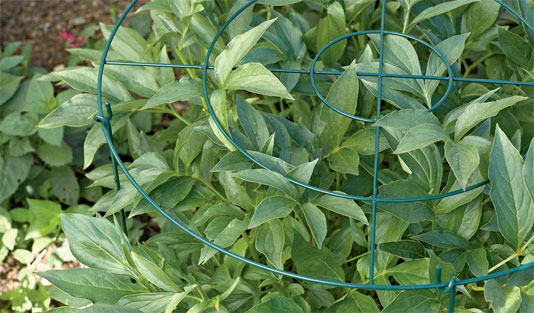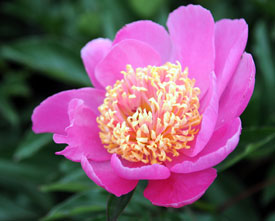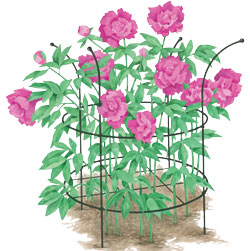






Grow-Through Supports are perfect for peonies.
PEONIES are one of the best-known and most dearly loved perennials. This is hardly surprising considering their sumptuous beauty and fragrance, trouble-free nature and longevity. Peonies also thrive almost anywhere in the country. Many varieties can even survive a zone 2 winter (that's a low of -50 degrees F).

When choosing peonies, give special consideration to the "singles", which are fragrant and gorgeous, but don't require as much staking.
If a peony is well situated and happy, it may bloom for 100 years or more with little or no attention. This means it's worth spending some time up front, choosing the right planting location and preparing the soil. That said, there are many stories about forgotten peony plants found blooming in the woods against old cellar holes. But like all plants, peonies will be healthier, more vigorous and more floriferous if they have ideal growing conditions.
Peonies prefer a sunny location with well-drained soil. Good air circulation around the plant is also important. These growing conditions help peonies avoid their only serious disease problem: botrytis. Like other fungal diseases, botrytis is present in most soils. It usually only becomes a problem if the plant is weak, the weather is unusually cool and wet, or if there are other infected plants nearby. Signs of botrytis are blackened buds and stems, and sometimes rotting at the base of the plant. Cut off and dispose of any affected areas (put this material in the trash, not in your compost pile). The best strategy for botrytis problems is prevention, and that goes back to proper planting.

With Adjustable Grow-Through Supports, you can raise the rings as peonies grow.
A special note for gardeners in the warm climates: Peonies will be more robust and their blooms will last longer if the plants receive some shade during the hottest part of the day. Peonies are an iffy prospect in warm zones, and impossible in some. To find out of they can be grown in your area, check with a good gardener in the neighborhood or your cooperative extension. To find out where your extension service is, start here: http://www.csrees.usda.gov/Extension/
To prepare the planting hole for a bareroot peony, dig the soil to a depth of 12-18". Use a garden fork to loosen the sides of the planting hole as well. Add a shovelful of compost and a handful of an all-purpose, organic, granular fertilizer, to the bottom of the hole and then add a shovelful of the original soil. Build up a "cone" of this amended soil inside the planting hole and then position the peony root on top of the cone with its roots hanging down the sides. It is very important that the "eyes", or growth nodes, located near the base of the old stem, end up no more than 2" below the soil surface. If the peony root is positioned deeper than this, the plant may grow well, but it will produce few if any blooms. Container-grown plants can be planted similarly. Just dig a hole that's twice as wide as the root ball but no deeper. Amend the soil as above. When planting, make sure the soil surface in the pot is at grade when the new plant is in the ground.
Peonies rarely bloom the first year after planting. It often takes three years before you see an abundant display of flowers. But once the plants do start blooming, you can look forward to a lifetime of beautiful flowers. Peony plants rarely need dividing. If a clump becomes too large for a given space, or you wish to share some of the plant with a friend, fall is the ideal time for dividing. Cut back the foliage and carefully lift the entire plant out of the ground. Use a sharp knife to cut apart some of the plant, making sure to create generous clumps of roots with at least three to five eyes per clump. Reposition the original plant back in the hole, taking care not to break off any of the relatively brittle roots or leave large pockets of air in the planting hole. Water until you are sure the moisture has reached the bottom of the hole and that the soil has settled around the roots. Plants that have been divided in the fall may not bloom the following spring, but will return to normal the next season.
A yearly application of organic, all-purpose fertilizer and a top-dressing of compost is all a peony requires for good health. If you mulch your flower beds, be sure to keep the mulch away from the base your peonies. If the base is covered with mulch, the plant reacts as if it has been planted too deep, and will produce few, if any, flowers.

Essex Plant Supports
Depending on the variety and the growing conditions, you'll probably want to provide your peonies with some support when the flowers are in bloom. This is especially true for the double or "bomb"-style blossoms, which can become waterlogged and very heavy. The supports should be positioned early in the growing season, before the plants get more than a few inches high. Once the plant has filled out, and especially when it's in bloom, it is nearly impossible to set up an effective support system.
There are hundreds of peony varieties on the market today, from heirloom favorites that have been enjoyed for centuries, to exciting new colors (peach, coral, yellow), interesting flower forms (spiders, singles and semi-doubles), and different heights and bloom times. You might also want to try your hand at growing tree peonies, which bloom earlier than herbaceous peonies, have larger blossoms and can grow up to 6 feet tall.
How come my peonies don't bloom?
Failure to bloom is usually caused by two things: improper planting and/or insufficient light. When planting peonies, make sure to plant the eyes (the point at which new growth emerges) no more than two inches deep. Also make sure your plants get plenty of sun — 6 or more hours a day. If they're planted in a shady site, they will not flower well — if at all.
Also note that newly planted peonies usually don't flower the first year, which is spent developing a good root system and foliage. By the second spring after planting, you should see your first blooms.
What are tree peonies?
Although tree peonies are related to regular (herbaceous) peonies, they are much larger, reaching up to 6 feet. Their form is actually more like a shrub than a tree. In colder zones, they will not grow as tall — 3 or 4 feet is typical. Plants bloom just before the regular peonies; flowers are equally fragrant.
Can peonies be divided?
Yes. Unlike most perennials, peonies rarely need to be divided. The only reason to do it is to get more plants — or share them with friends. It's best done in the fall. Dig up the clump and use a sharp tool to divide it into sections, keeping three to five eyes in each division. Be sure to water the transplants thoroughly, unless you get plenty of rainfall. Keep in mind that divisions (and transplants) might not begin blooming again for two or three years.
Ants are crawling all over my peony buds. Are they going to eat the flowers?
No. These insects are merely enjoying the sugary syrup produced by the buds and are doing no harm to the plant.
The foliage on my peony has blackened and wilted. What can I do?
Peonies suffer from very few pest and disease problems. Nevertheless, they sometimes get fungal diseases, such as botrytis blight, which you describe. Other similar problems include blackened and/or rotten stems, withered buds, gray mold near the base of the plant. In all cases, remove and destroy the infected plant parts. Make sure the plants aren't getting overwatered; avoid sites with poorly drained soil. Good air circulation around the plant will also minimize fungal problems. Powdery mildew can be a problem near the foundation of a house, where there is lots of roof runoff and splashing. Consider moving the plant to another location if you see powdery mildew every year. To prevent problems, do a thorough clean-up after fall frosts. Cut the stems to 3" from the ground and clear away the foliage.
We recently moved to Florida and want to grow peonies like we did in Connecticut. Is there a way we can do it?
Unfortunately, you cannot grow peonies successfully in Florida, southern California and most of the deep south. Zone 8 is the warmest zone for peonies. And if you're growing them in zone 8, it's wise to check locally to see which varieties are known to thrive.
My peonies are gorgeous, but when it rains, the flowers bend to the ground. How can I prevent this?
The best solution is a grow-through support, which helps keep the top-heavy blooms upright. Ring supports will also work, but they aren't quite as "invisible" as the grids. Be sure to put the grids in place in early spring — before the plants are more than a few inches tall.
Copyright © www.100flowers.win Botanic Garden All Rights Reserved